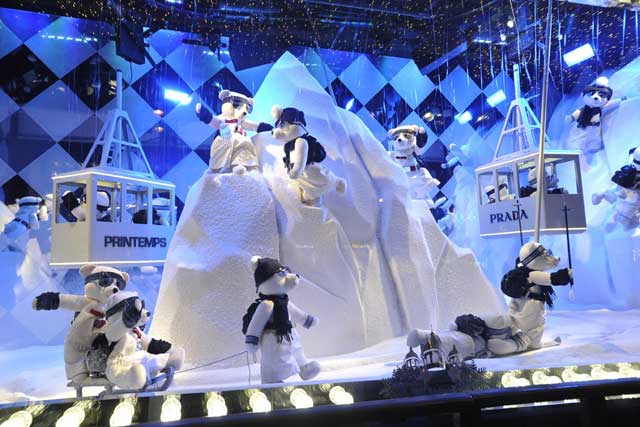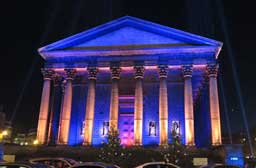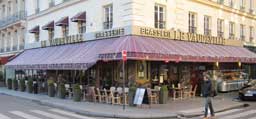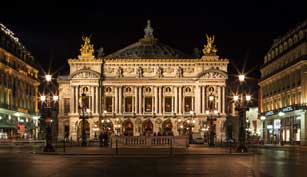Over the course of the last 20+ years when my husband, Michael, and I have found ourselves in Paris at Christmastime, we have noticed a trend toward ever more elaborate decorations and light shows. December of 2013 offered the most lavish yet, combining feasts for the eyes and ears while capping memorable meals at beloved French institutions.

Paris’ two major department stores or grands magazins on the Boulevard Hausmann, Galeries Lafayette and Au Printemps, battle each year for the most captivating Christmas display windows. The stores are architectural beauties in their own right with atriums below enormous stained glass domes. Built in the second half of the 19th century amidst Baron Hausmann’s clearing and redesign of Paris’ Right Bank, the stores were the first to lease “departments” to fashion houses in what gave birth to the concept of the modern department store.
In this year’s rivalry for window supremacy, Printemps prevailed with animated scenes designed and executed by just such a department – Prada. One window featured an ingenious workshop manned by industrious bears crafting miniature Prada purses. Another involved bears dressed in fashionable Prada dresses, sporting Prada sunglasses, and wielding candy canes as they danced the cancan. Our favorite involved polar bears in Prada winter outfits skiing, sledding, climbing a mountain, and soaring in cable cars, all to the accompaniment of classics by French composers.
Just when we thought it couldn’t get any better, the loudspeakers switched to the Aquarium section of Camille Saint-Saëns’ Carnival of the Animals, which never fails to stir our hearts with its shimmering arpeggios. How delighted we were to hear France’s great romantic period composer (who lived from 1835 to 1921) featured on this spot so close to the Church of Saint Mary Magdalene, known as the Madeleine, where he was organist for twenty years. Saint-Saëns had insisted that Carnival, perhaps his best-loved and most enduring work, not be published or performed until after his death for fear it would not be viewed as the output of a “serious” composer.

This Christmas season the enormous Madeleine church, designed in the style of a Roman temple, had its own elaborate light show highlighting architectural details and sculpture not generally visible since Saint-Saëns’ time. Beams from giant spotlights intersected in the sky above, in the shape of the Star of Bethelehem. We could imagine Saint-Saëns strolling down Rue Tronchet to Boulevard Hausmann after a rehearsal at the church and nipping into Printemps for a bit of shopping. We hope he would have delighted in seeing his church bathed in colored lights while hearing his music outside Printemps as part of a memorable Noël spectacle.
While Saint-Saëns preferred the swan among the animals featured in his Carnival, we were focused more on ugly ducklings for our culinary samplings around Paris, taking us to rendez-vous at two of the city’s oldest eateries.
We had lunch with our friend Caroline at Le Bistrot des Halles, a short walk from her office at France’s space agency by the huge construction site that stretches over the Chatelet-les-Halles Metro station and underground shopping center to the steps of Saint Eustache church. From the 12th century to 1971 this area was home to Paris’ wholesale food market known as Les Halles. As a result, numerous eateries serving the freshest of meats and charcuterie dotted the landscape and a few, such as Le Bistrot des Halles, remain in what is now a neighborhood of offices and shops.
By the time we arrived, this diminutive temple of traditional dishes was already packed with hungry Parisians, but we were shoe-horned into a tiny spot at a table barely large enough to hold the Salades Périgourdines all three of us ordered. This duck-lover’s delight was our default choice since the Bistrot had already sold out of the day’s special, roasted duck breast. Our selection proved scrumptious — field greens, haricots verts, tomato, slices of smoked duck breast, all crowned with the most tantalizing slice of duck foie gras we had ever tasted. To accompany it we had a bottle of the day’s featured wine, a Chinon (Jean-Mauice Raffault 2012 Les Galuches), the classic red wine of the Loire Valley. All around us, diners were digging into plates of other bistrot staples such as steak tartare and piles of fried potatoes. At the zinc counter doubling as a wine bar, regulars enjoyed a liquid lunch before heading back to the office.

Another memorable meal was provided by Le Vaudeville, a brasserie or brewery. This type of restaurant dates back to the Franco-Prussian War (1870) when beer-loving refugees from Alsace fled to Paris and opened eateries. Still somewhat casual, the brasserie is a notch above the bistrot or bistro in the French hierarchy of formality for establishments serving food.
Our friend and former long-time resident of Houston, Dominique, suggested Le Vaudeville for its great food and authentic décor dating back to the early 20th century. Its name pays tribute to the theater called Le Vaudeville that once had a temporary location in the Salle de la Bourse across from the restaurant. It was in this famous theater that Giuseppe Verdi saw Alexandre Dumas’ play, La Dame aux Camélias, which inspired one of the composer’s greatest hits and perennial Paris favorites, La Traviata.
As an aperitif, we enjoyed a refreshing glass of Gewürtztraminer from the 200 year-old winery of Bestheim in Alsace. A vendange tardive or late harvest offering, it was crisp and mellow, with a sweetness that was intense but not cloying. Hands down, it was one of the best Alsatian wines we have ever tasted.
One of the joys of French restaurants is reading the detailed descriptions, verging on an entire recipe, of items on the menu. Le Vaudeville excels at this. For example, the guys started with soup – velouté de lentillons de Champagne, crème fouettée au foie gras de canard, croûtons dorés. The main ingredients of lentils, duck liver, and cream all blended perfectly in a texture so smooth that no single flavor was dominant – like a symphony by Saint-Saëns.

For the main course there were many temptations but all three of us opted for veal liver with a subtle sauce of parsley, garlic and aged vinegar – foie de veau français poêlé en persillade, vinaigre d’Orléans “Vielle Réserve” et purée de pommes de terre à la fleur de sel. The liver was delicately breaded and pan-fried to pink perfection, accompanied by a purée of potatoes. A seemingly mundane dish, these mashed potatoes were a stand-out due to the intense flavor of the variety of potato (which no one could identify) and inclusion of generous amounts of creamy and flavorful French butter as well as the special finish known as "flower of salt" (that we learned more about from a TV show on Air France on the way home). We washed it all down with a pichet of red Bordeaux, a great alternative to ordering a whole bottle. Michael was the only one who opted for dessert, but it was a doozy and the best of the trip — a chocolate, raspberry and salted caramel extravaganza described as croquante feuillantine à grand cru de chocolat Manjari et framboises, caramel laitier à la fleur de sel.
After the meal, we bundled up and strolled back to our hotel along the Rue du Quatre-Septembre, a street commemorating a key date in the Franco-Prussian War. It empties onto the Place de L’Opéra where flood lights illuminated the magnificent Opéra Garnier in its Neo-Baroque splendor. A feast for the senses, Paris knows better than any city on earth how to enchant visitors and keep them coming back with a hunger and a thirst for more.
Le Bistrot des Halles, 15 Rue des Halles, 75001 Paris (no website)
Brasserie Le Vaudeville, 29 rue Vivienne, 75002 Paris
Next time, bingeing on Modernismo in Barcelona.
The original version of this article appeared in the Winter, 2013 edition of the Quarterly Newsletter of the Wine Society of Texas, a non-profit organization dedicated to wine education and appreciation.